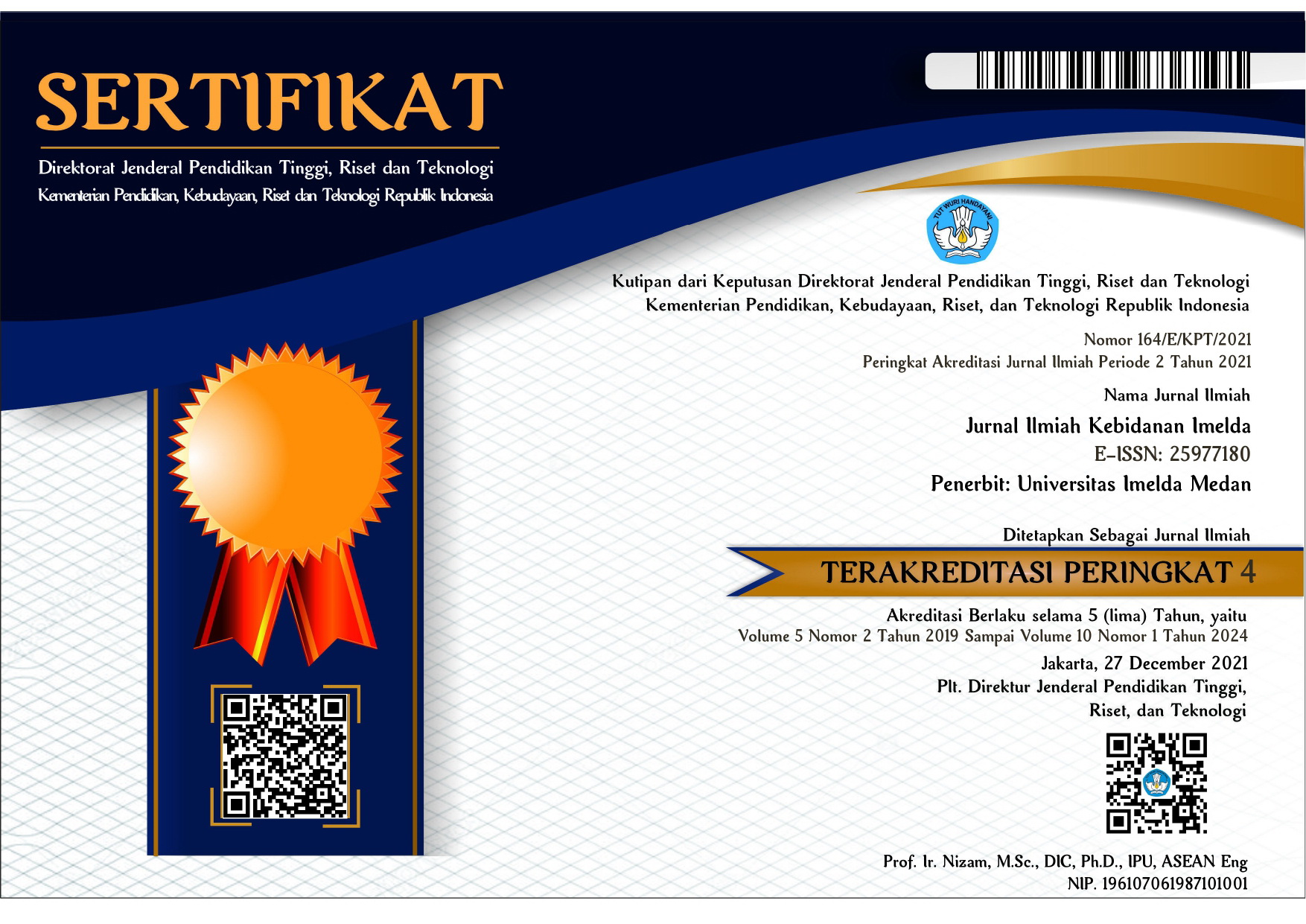HUBUNGAN PENGETAHUAN DAN SIKAP DENGAN KEJADIAN KEPUTIHAN PADA REMAJA PEREMPUAN DI SMA PASUNDAN 1 KOTA BANDUNG
DOI:
https://doi.org/10.52943/jikebi.v11i1.1758Keywords:
Knowledge category, Attitude Category, Vaginal Discharge IncidentAbstract
According to the World Health Organization (WHO), around 75% of women in the world experience vaginal discharge at least once in their lives, and 45% experience it twice or more. Factors that influence are lack of knowledge and attitudes in maintaining the cleanliness of the feminine area. Some adolescent girls sometimes take this vaginal discharge problem lightly. Thus, efforts are needed to improve knowledge and attitudes about the problem of vaginal discharge. This study uses descriptive correlation with a cross-sectional approach, the sample used was 98 female adolescents in grade XI IPA. The researcher's goal is to determine the relationship between the level of knowledge and attitudes with the incidence of vaginal discharge in adolescent girls. Statistical tests using the Fisher Exact Probability Test with the highest frequency of knowledge, namely the good category of 78 respondents (79.6%), attitude, namely the good category of 75 respondents (76.5%), it is known that the knowledge value is (p = 0.119 > ? = 0.005) meaning that there is no relationship between knowledge and the occurrence of vaginal discharge, while attitude is (p = 0.003 < ? = 0.005) meaning that there is a relationship between attitude and the occurrence of vaginal discharge.
References
[2] St. Nurul Izzah Habibarrahman, Muh. Khidri Alwi, and N. U. Mutthalib, “Faktor yang Berhubungan dengan Gangguan Keputihan pada Siswi di MA Muhammadiyah Sibatua Pangkajene,” Wind. Public Heal. J., vol. 2, no. 6, pp. 1338–1347, 2021, doi: 10.33096/woph.v2i4.339.
[3] J. Eduwan, “Gambaran Pengetahuan Tentang Keputihan Pada Remaja Putri,” J. Vokasi Keperawatan, vol. 5, no. 1, pp. 71–77, 2022, doi: 10.33369/jvk.v5i1.22449.
[4] W. Widyaningsih, K. D. Rahayu, E. A. Hastuti, P. Studi, and S. Keperawatan, “Hubungan Perilaku Vulva Hygiene Dengan Kejadian Keputihan Pada Remaja Putri Di SMP Swasta Kota Bandung 70 % dan sebanyak 50 % remaja putri mengalami keputihan . Menurut data statistik ( 2018 ) dalam,” vol. 3, 2022.
[5] E. Amalia, N. Wulandari, Y. Andriani, and F. Wartisa, “Faktor-Faktor Yang Berhubungan Dengan Kejadian Keputihan Pada Remaja Putri,” Pros. Semin. Kesehat. Perintis, vol. 5, no. 2, pp. 8–14, 2022, [Online]. Available: https://jurnal.upertis.ac.id/index.php/PSKP/article/download/938/416/
[6] S. Y. Ilmassalma, H. E. Wardani, and A. Hapsari, “Hubungan Pengetahuan dan Sikap Terhadap Kejadian Keputihan,” Sport Sci. Heal., vol. 3, no. 9, pp. 663–669, 2021, doi: 10.17977/um062v3i92021p663-669.
[7] L. L. Sari, T. Rossita, and Y. Putri, “Keputihan patologis disebabkan oleh infeksi ( Jamur , kuman , parasite dan virus ) penyebab lain keputihan patologis yaitu kurangnya perawatan remaja putri terhadap kebersihan alat genetalia seperti,” J. Kreat. Pengabdi. Kpd. Masy., vol. 5, no. 3, pp. 737–744, 2022.
[8] W. Nengsih, A. Mardiah, and D. A. S, “Hubungan Pengetahuan Tentang Keputihan, Sikap Dan Perilaku Personal Hygens Terhadap Kejadian Flour Albus( Keputihan ),” Hum. Care J., vol. 7, no. 1, p. 226, 2022, doi: 10.32883/hcj.v7i1.1457.
[9] E. Yunitasari, A. Triningsih, and R. Pradanie, “Analysis of Mother Behavior Factor in Following Program of Breastfeeding Support Group in the Region of Asemrowo Health Center, Surabaya,” NurseLine J., vol. 4, no. 2, p. 94, 2020, doi: 10.19184/nlj.v4i2.11515.
[10] N. Hanipah and N. Nirmalasari, “Gambaran Pengetahuan Dan Sikap Vulva Hygiene Dalam Menangani Keputihan (Fluor Albus) Pada Remaja Putri,” J. Kesehat. Mesencephalon, vol. 6, no. 2, pp. 132–136, 2021, doi: 10.36053/mesencephalon.v6i2.242.
[11] Y. Herdayani et al., “Faktor-Faktor Yang Berhubungan Dengan Kejadian Keputihan Pada Remaja Putri (Literature Review),” pp. 83–90, 2020.
[12] M. A. Wulandari, E. Wisanti, and D. R. Adila, “Hubungan Pengetahuan Dan Sikap Perineal Hygine Dalam Pencegahan Keputihan Remaja Di Pondok Pesantren Modern Diniyah Puteri Pekanbaru,” J. Ilmu Keperawatan, vol. 12, pp. 169–177, 2023.
[13] S. T. Oklaini, W. Apriani, and P. Omelia, “Hubungan Pengetahuan Dan Sikap Remaaja Putri Dengan Kejadian Flour Albus di SMKN 3 Seluma,” J. Kesehat. Maharatu, vol. 2, no. 4, pp. 47–59, 2021.
[14] Darsini, Fahrurrozi, and E. A. Cahyono, “Pengetahuan?; Artikel Review,” J. Keperawatan, vol. 12, no. 1, p. 97, 2019.
[15] I. Mastikana and T. Silvia, “Hubungan Pengetahuan Dan Sikap Tentang Menjaga Kebersihan Genetalia Dengan Kejadian Keputihan Pada Remaja Putri Di Sma Negeri 5 Batam,” J. STIKes Awal Bros Pekanbaru, vol. 1, no. 2, pp. 1–10, 2020, doi: 10.54973/jsabp.v1i2.24.
[16] A. P. Ardhini, R. Isyawati, and P. Ganggi, “DI INSTAGRAM”.
[17] Sahpitri, Solihati, and R. P. Sari, “Hubungan Pengetahuan Dan Sikap Remaja Terhadap Tingkat Kejadian Flour Albus Di Desa Lebak Wangi Rt/Rw 007/007 Kabupaten Tangerang,” Nusant. Hasanah J., vol. 1, no. 8, pp. 141–145, 2021, [Online]. Available:
[18] E. Destariyani, P. P. Dewi, and E. Wahyuni, “Hubungan pengetahuan dan sikap dengan keputihan,” J. Ilm. Kebidanan (The J. Midwifery), vol. 11, no. 1, pp. 58–63, 2023, doi: 10.33992/jik.v11i1.2525.
[19] F. H. Darmawan and L. Haryani, “Pengetahuan, Sikap dan Kejadian Fluor Albus pada Ibu Rumah Tangga di Klinik IMS Cipatat Kabupaten Bandung Barat tahun 2018,” Proceeding Publ. Creat. Res. MLT DIV, vol. 1, no. 1, pp. 13–21, 2019, [Online]. Available: http://ckd.vacloud.us/rooms/kidney-info/topics/how-to-protect-your-kidneys/#slide_2









